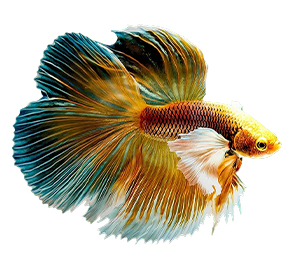Siamese fighting fish, also known as bettas, are popular aquarium fish known for their striking colors and flowing fins. They are often kept in small aquariums or bowls, but it’s important to provide them with a proper environment to ensure their health and well-being.
Is Siamese Fighting Fish Good For Home Aquariums or Fish Tanks?
Siamese fighting fish can make great additions to home aquariums or fish tanks. They are relatively easy to care for and can be kept in small tanks, making them suitable for people who have limited space for larger aquariums.
In addition to their striking colors and flowing fins, Siamese fighting fish are known for their personalities. They can be quite active and curious, and some even learn to recognize their owners and follow their movements.
However, it’s important to note that betta fish are not always compatible with other fish, as they can be aggressive toward their tank mates. It’s generally recommended to keep Siamese fighting fish on their own or with other peaceful fish species that won’t nip at their fins or provoke them.
Disclosure: This article contains affiliate links. When you follow a link to purchase the products, I sometimes earn a commission, at no additional cost to you. Read my full disclosure here.
Siamese fighting fish, overall, can be a good choice for home aquariums or fish tanks as long as their needs are met and they are kept in suitable environments
Which Fish Tank or Aquarium Type is Best for Siamese Fighting Fish?
Siamese fighting fish have specific requirements for their tank setup. Here are some factors to consider when choosing a fish tank or aquarium type for your betta fish:
- Tank size – Siamese fighting fish require a minimum tank size of 5 gallons. A larger tank is always better, as it provides more space for swimming and ensures a stable environment.
- Shape – Siamese fighting fish prefer long and shallow tanks as opposed to tall tanks. This is because these fishes are top swimmers and need plenty of surface area to breathe air.
- Filtration – A filtration system is necessary to keep the tank clean and the water parameters stable. However, bettas prefer gentle filtration, as they don’t like strong water currents.
- Heating – Siamese fighting fish are tropical fish and require a consistent water temperature between 75-82°F. A heater is necessary to maintain this temperature range.
- Decorations – Siamese fighting fish appreciate places to hide and explore, so adding some plants, rocks, and caves to the tank can make them feel more comfortable.
- Tankmates – Siamese fighting fish are known to be aggressive towards other fish and may attack or even kill tankmates. However, it is possible to keep them with compatible tankmates if the tank is large enough, and if the other fish are peaceful and have long fins that do not resemble. Some compatible tankmates of Siamese fighting fish include African dwarf frogs, Corydoras catfish, snails, neon tetras, and guppy fish.
Based on these factors, a long and shallow tank with compatible tankmates, a gentle filtration system, a heater, and some decorations are the best option for Siamese fighting fish.
What is The Diet of Siamese Fighting Fish?
The diet of Siamese fighting fish consists of both carnivorous and herbivorous food. In the wild, they eat a variety of insects, small crustaceans, and zooplankton.
Talking specifically about Siamese fighting fish and their diet in In captivity or fish tanks, they can be fed a diet of high-quality fish flakes or pellets specifically formulated for such types of fish. It’s important to avoid overfeeding them, as they can easily become overweight.
Additionally, you can supplement their diet with small amounts of live or frozen foods such as bloodworms, brine shrimp, and daphnia. It’s also recommended to vary their diet and provide them with occasional treats such as boiled and skinned peas or blanched spinach.
Is Siamese Fighting Fish Food Easily Available in the Market?
Siamese fighting fish food is easily available in the market. Most pet stores that sell fish supplies will carry a variety of fish food options, including food specifically formulated for Siamese fighting fish. In addition to physical stores, there are also numerous online retailers that sell Siamese fighting fish food.
General Information and Stats on Siamese Fighting Fish
| Factors/ Characteristics | Details |
| Minimum Tank Size | 5 gallons (for a single Betta) |
| Care Level | Moderate |
| Temperament | Aggressive (towards other male Siamese Fighting Fish) |
| Reef Compatibility | Not Reef Safe (may nip at corals and invertebrates) |
| Water Conditions | pH: 6.5-7.5, Temperature: 76-82°F, Ammonia/Nitrite/Nitrate: 0 ppm, Hardness: 5-20 dGH |
| Maximum Growth Size | 2.5-3 inches |
| Color Variations | A wide range of colors and patterns, including blue, red, green, purple, white, black, and more. Some have solid colors, while others have iridescent or metallic hues. |
| Diet | Primarily carnivorous, with a diet that should consist of high-quality Betta pellets, freeze-dried or frozen bloodworms, brine shrimp, and other small live or frozen foods. |
| Compatible Tankmates | Best kept alone due to their territorial nature.
Can coexist with some fish and invertebrates if the tank is large enough and there are plenty of hiding places. Good tankmates may include small, peaceful fish like neon tetras, guppies, and Corydoras catfish, as well as some shrimp and snail species. Avoid aggressive or fin-nipping fish, as well as other male Betta fish. |
| Other Information | Siamese fighting fish need plenty of hiding places and surface area to breathe, so it is important to provide plants, caves, and other decorations in the tank. They may also benefit from the addition of Indian almond leaves, which can help to replicate their natural habitat and provide tannins that have antifungal and antibacterial properties. Regular water changes and proper filtration are also essential for their health and well-being. |
Siamese Fighting Fish Infographic




